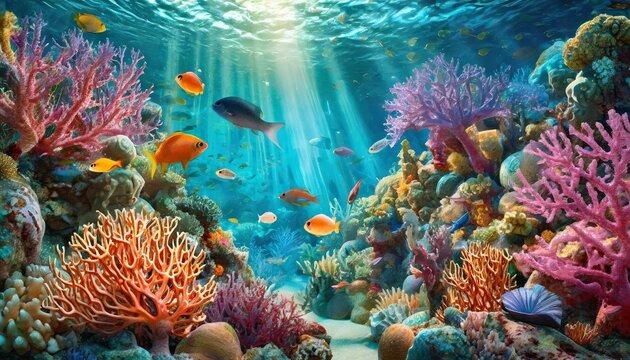Discovering the Enigmatic Creatures of the Deep Sea

Discovering the Enigmatic Creatures of the Deep Sea
The deep sea, with its depths beyond sunlight’s reach, remains one of the most mysterious and least explored environments on Earth. Here, creatures have evolved unique adaptations to survive in extreme cold, darkness, and high pressure. Let’s delve into the fascinating world of deep-sea creatures, each one a testament to the wonders of evolutionary adaptation.
By Khushi Maheshwari
1. Frilled Shark
The frilled shark (Chlamydoselachus anguineus) is a living fossil, resembling a mix between a snake and an eel. It possesses a long, cylindrical body with distinctive fringed gill slits, giving it a frilled appearance. Found at depths of 390 to 4,200 feet, these sharks are rarely encountered by humans due to their deep-sea habitat.
2. Giant Squid
One of the most iconic deep-sea creatures, the giant squid (Architeuthis dux) is known for its enormous size and elusive nature. It can grow up to 43 feet in length, with eyes the size of dinner plates. Despite its size, much of what we know about giant squids comes from specimens that wash ashore or are caught accidentally by fishermen, highlighting the difficulty of studying these deep-sea giants in their natural habitat.
3. Barreleye Fish
Barreleye fish (Macropinna microstoma) are known for their transparent, dome-shaped heads through which their barrel-shaped eyes can rotate to look upwards or forwards. Found at depths of 2,000 to 2,600 feet, these fish have adapted to their deep-sea environment by possessing sensitive tubular eyes that help them locate prey and navigate in the dimly lit waters.
4. Fangtooth
The fangtooth (Anoplogaster cornuta) holds the title of having the largest teeth relative to body size of any fish. Despite its intimidating appearance, with teeth so large they cannot close their mouths fully, fangtooth fish are relatively small, reaching lengths of about 6 inches. They inhabit depths of up to 16,000 feet and have a diet that includes small fish and crustaceans.
5. Cookie Cutter Shark
The cookie cutter shark (Isistius brasiliensis) is named for its feeding habit of gouging round plugs of flesh from larger marine animals, leaving behind circular wounds resembling cookie cutter shapes. These small sharks, typically around 20 inches in length, are found at depths of 1,000 to 3,200 feet. They have bioluminescent organs called photophores that help them attract prey in the dark depths.
6. Dumbo Octopus
Named after the Disney character due to its ear-like fins, the dumbo octopus (genus Grimpoteuthis) is a group of deep-sea umbrella octopuses. They live at depths ranging from 9,800 to 13,100 feet and are known for their unique method of propulsion—flapping their ear-like fins to move gracefully through the water. Dumbo octopuses feed on small crustaceans and mollusks found on the deep-sea floor.
7. Deep-Sea Dragonfish
Deep-sea dragonfish (family Stomiidae) are known for their long, slender bodies and bioluminescent organs called photophores. These fish inhabit depths of 1,000 to 5,000 feet and use their luminous chin barbels to attract prey in the darkness. They have elongated jaws with sharp, fang-like teeth, making them formidable predators in their deep-sea environment.
8. Anglerfish
Anglerfish (order Lophiiformes) are perhaps most famous for the bioluminescent lure that extends from their heads. Found at depths of 660 to 3,300 feet, anglerfish use this lure to attract prey close enough to ambush. They have large mouths and expandable stomachs, allowing them to consume prey larger than themselves. In some species, females are much larger than males and practice a unique form of parasitic reproduction.
9. Gulper Eel
The gulper eel (Eurypharynx pelecanoides) is a deep-sea fish known for its large mouth, which it can expand to swallow prey much larger than itself. It inhabits depths ranging from 1,000 to 6,000 feet and uses its bioluminescent photophores to attract prey in the darkness. Despite its intimidating appearance, the gulper eel is relatively fragile and has a delicate, gelatinous body.
Conclusion: Unveiling the Deep-Sea Mysteries
The deep sea remains one of the least explored frontiers on our planet, with countless species yet to be discovered and understood. The creatures that inhabit these extreme environments have evolved incredible adaptations—from bioluminescence and transparent bodies to bizarre forms and feeding strategies—to survive in conditions that are inhospitable to most life forms. Studying these deep-sea organisms not only reveals their adaptations but also provides insights into the resilience and diversity of life on Earth. As we continue to explore and uncover the mysteries of the deep sea, we gain a deeper appreciation for the complexity and beauty of our oceans’ hidden realms.









